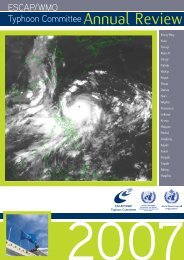TCAR - Typhoon Committee
TCAR - Typhoon Committee
TCAR - Typhoon Committee
Create successful ePaper yourself
Turn your PDF publications into a flip-book with our unique Google optimized e-Paper software.
300<br />
ESCAP/WMO<br />
<strong>Typhoon</strong> <strong>Committee</strong> Annual Review 2009<br />
6. Comments and conclusion<br />
This study considered TS track forecast skill of<br />
the CMA’s TS track prediction system including<br />
the global model version T213L31 and vortex<br />
initialization scheme by analysing model forecasts<br />
for 10 TSs of complicated tracks during 2006 –<br />
2009 in WNPAC to find model’s systematic errors<br />
and bias, then conducting numerical experiments<br />
for TY PARMA (0917) and TY FENGSHEN (0806)<br />
by using CMA’s global spectral model and vortex<br />
initialization scheme with last improvements and<br />
modifications.<br />
Overally, the statistic showed that the CMA’s<br />
TS track prediction system had good forecast<br />
skill performance in term of mean track errors<br />
for majority of TSs with complicated tracks<br />
considered in this study for +24h, +48h and +72h<br />
forecast periods. However, it is obvious that in<br />
many track forecasts there is northward bias.<br />
Also, the track forecast errors are large when TS<br />
changes its motion direction or speed. This could<br />
be explained by many different factors including<br />
limitation in model physics, model resolution,<br />
physical parameterizations and initial conditions.<br />
To overcome the sparity of observations in<br />
ocean vortex initialization schemes are used for<br />
presenting TS bogus vortex in initial conditions<br />
to be similar to the observed TS based on the<br />
theoretical research and observational results.<br />
This approach brought very encouraging<br />
improvement in TS track forecasts accuracy.<br />
The improvement in CMA’s model track forecast<br />
accuracy for TY FENGSHEN in EXP 2 by<br />
better representing sea level pressure for TS<br />
bogus vortex in vortex modification step one<br />
again emphasied the important role of vortex<br />
initialization scheme in TS track forecast system.<br />
However, how to select appropriate parameters<br />
for correctly representing TS structure and<br />
surrounding environmental flow structure, their<br />
intensity, their size, their interaction in vortex<br />
initialization scheme so that this will contribute<br />
to further improvement in model track forecast<br />
accuracy overally and in case of TS complicated<br />
track is still a big challenge for reseach and<br />
experiments as results of EXP 4 for TY PARMA<br />
showed. Further serious research should be<br />
conducted in this aspect.<br />
Acknowledgements<br />
This research was financially supported by<br />
China Meteorological Administration (CMA)<br />
in TRCG Fellowship Scheme 2009 of WMO/<br />
ESCAP <strong>Typhoon</strong> <strong>Committee</strong> and was carried out<br />
in <strong>Typhoon</strong> and Marine Meteorological Forecast<br />
Centre, National Meteorological Center (NMC) of<br />
CMA . The authors would like to express special<br />
thanks to Shuhong Ma, Qu Anxiang, Zhang Jin<br />
and other staffs in NMC for providing CMA’s<br />
typhoon model forecasts, materials, references<br />
and very valuable supporting. Also, we are very<br />
grateful to Hydrometeorological Service of SR<br />
Vietnam (VHMS) and Thailand Meteorological<br />
Department (TMD) for nominating us to CMA.<br />
References<br />
Davidson, N.E., J. Wadley, K. Puri, K.Kurihara<br />
and M. Ueno, 1993 : Implementation of<br />
JMA typhoon bogus in the BMRC tropical<br />
prediction system. J. Meteor. Soc., Japan, 71,<br />
437-467<br />
Davidson, N.E. and H.C. Weber ,2000 :The<br />
BMRC high resolution TC prediction<br />
system:TCLAPS. Mon.Wea.Rev.,128, 1245-<br />
1265<br />
Heming, J.T., and A. M. Radford, 1998 : The<br />
performance of the United Kingdom<br />
Meteorological Office global model in<br />
predicting the tracks of Atlantic TCs in 1995.<br />
Mon.Wea.Rev.,126, 1323-1331<br />
Iwasaki, T., H. Nakano, and M. Sugi, 1987 : The<br />
performance of a typhoon track prediction<br />
model with cumulus parameterization.<br />
J.Meteor.Soc.Japan, 65, 555-570.<br />
Kurihara, Y., M.A. Bender and R.J.Ross, 1993 :<br />
An initialization scheme of hurricane models<br />
by vortex specification. Mon.Wea.Rev., 121,<br />
2030-2045.<br />
Kurihara, Y., M.A. Bender, R.E. Tuleya and<br />
R.J.Ross, 1995 : Improvement in the GDFL<br />
hurricane prediction system. Mon.Wea.<br />
Rev.,123, 2791-2801.<br />
Kurihara, Y., R.E. Tuleya, and M. A. Bender, 1998<br />
: The GFLD hurricane prediction system<br />
and its performance in the 1995 hurricane

















